20×30 (Signing) The Declaration of Independence and 8×10 storyboard and diagram
$30.00
20×30 print of “(Signing) The Declaration of Independence” and 8×10 storyboard and diagram — FREE SHIPPING on all orders over $50, $4.95 for orders under $25, and $9.95 for orders between $25 and $50.
The session of Congress that began in May 1776 concluded with signing the Declaration of Independence on August 2, 1776. George Washington and Mrs. Washington arrived in Philadelphia in mid-May, and the General advised Congress that any hope of accommodation with Great Britain was useless, reminding them that he was facing foreign mercenary troops (Hessians) that showed “unsparing hostility.” He also asked for three-year enlistments instead of only one-year terms for his troops. Then he and Mrs. Washington returned to New York on June 7, 1776, and the Second Continental Congress continued debating on the matter of independence along with Washington’s request to approve a permanent army.
The Congress consisted of representatives from all 13 colonies that were gentlemen of solid responsibility and high social position–including Benjamin Franklin, John Adams, Thomas Jefferson, Richard Henry Lee, Charles Carroll, Robert Morris, John Hancock, James Wilson, Roger Sherman, and George Walton. Such men had everything to gain by standing with King George. If they joined the rebels, they risked not only their own lives, but also the lives of their families. Under English law, their children and their children’s children would remain traitors.
Each man attending the meeting possessed a landed estate, a substantial business, a professional position–or all three. By keeping quiet, he might save his property, his superior class status, and his life. And he could easily justify his position on the premise that, while he might not wholly agree with the government’s policies, a good subject’s duty is to obey the laws and remain loyal to his king.
To convince a vacillating Congress, John Adams articulated his sentiments:
Sink or swim, live or die, survive or perish, I give my hand and heart to this vote. It is true indeed, that in the beginning we aimed not at independence. But, there’s a divinity that shapes our ends…why then, should we defer the Declaration? You and I, indeed may rue it. We may not live to the time when this Declaration shall be made good…But whatever may be our fate, be assured…that this Declaration will stand. It may cost treasure, and it may cost blood, but it will stand, and it will richly compensate for both.
Even though the colonies were unanimous in their decision to declare independence, some of the representatives refused to sign the document. Each man who did sign knew what he risked when he wrote his signature under the words: We mutually pledge to each other our Lives, our Fortunes, and our sacred Honor.
On August 2, 1776 the delegates began to sign the prepared copy of the Declaration of Independence. John Hancock, President of the Continental Congress, was first to sign. He wrote in large letters and said, “There! John Bull [a fictitious personification of Great Britain] can read my name without spectacles, and may now double his reward of $500 for my head. That is my defiance.”
It is recorded that John Hancock said, “We must be unanimous. There must be no pulling different ways: we must all hang together.” Ben Franklin added, “Yes, we must all hang together, or most assuredly we shall all hang separately.”
And finally, John Adams wrote of the day, “This is our day of deliverance. With solemn acts of devotion to God we ought to commemorate it. With pomp and parade, with shows, games, sports, guns, bells, bonfires and illuminations from one end of the continent to the other from this time forward forevermore…”
Before that could happen though, there was a war to fight and win.
John Trumbull was the son of the Governor of Connecticut and grew up in privileged circumstances. He showed an early talent for art and graduated from Harvard University in 1773 at age 17, the youngest person in his class. He served 18 months in the Continental Army, and in 1777 began painting portraits in Boston. The Declaration of Independence painting proved to be the most important work of John Trumbull’s life. He collaborated with Thomas Jefferson to make this painting and used actual sittings with most of the signers to produce this fine work. He began in 1787 and did not finish until 1820. Trumbull lived to age 88 and died in 1843 in New York City. He and his artist wife, Sarah Hope Harvey, are buried beneath the current Yale University Art Gallery, which house the collection of the artist.

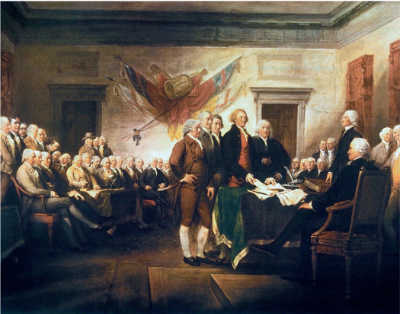
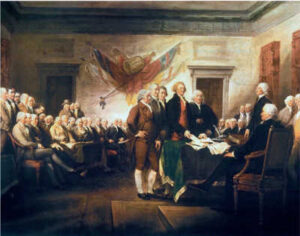
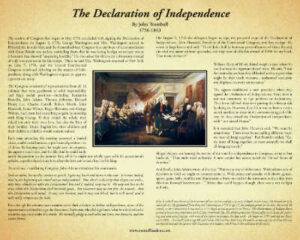
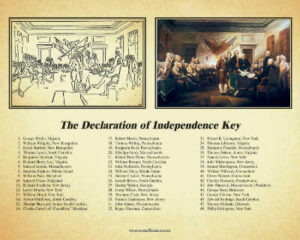
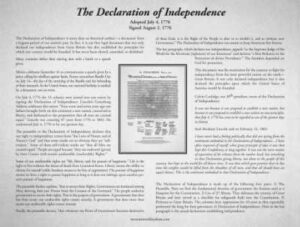
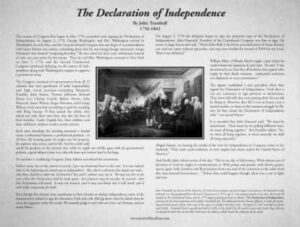
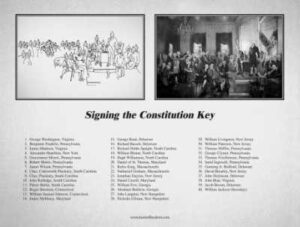
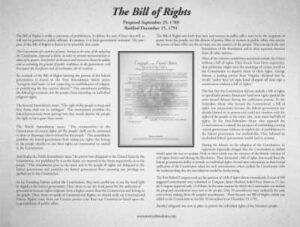
Reviews
There are no reviews yet.